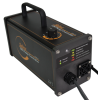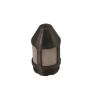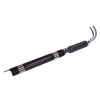Solinst Model 415 12V Submersible Pump
Features
- Very simple to operate and adjust from high to low flow rates
- Smooth, short (6" nominal) pump design avoids getting stuck in wells
- Fits inside Nominal 2" OD Sched. 40 or 80 PVC Pipe
- Free ground shipping
- Expedited repair and warranty service
- Lifetime technical support
- More
Overview
The Solinst 12V Submersible Pump provides an efficient means of purging and obtaining groundwater samples from monitoring wells. The 12V Submersible Pump and 12V Pump Controller are lightweight, portable, and easy to set up, deploy and operate.
Application
The Pump’s sleek, short design ensures it fits easily down wells without hang-ups. The Solinst 12V Submersible Pump is capable of pumping groundwater from 36.5 m (120 ft) below ground surface, with flow rates up to 13.5 L/min (3.6 US gpm) in shallow conditions.
Mechanics
The Solinst 12V Submersible Pump system comprises the 12V Submersible Pump with cable, 12V Pump Controller, sample tubing (sold separately), and a user-supplied power source. The 12V Submersible Pump cable simply connects to the 12V Pump Controller, which then clips to a 12V power source. The 3/8" (9.5 mm) ID LDPE sample tubing is pushed onto the barbed fitting on the 12V Pump.
Design
Convenient LED lights on the Controller indicate the status of the 12V Submersible Pump system, including high or low battery voltage, proper battery connection, normal operation and maximum flow rate. It has an easy-to-reset circuit breaker (no fuse to replace). Simply turn the dial on the 12V Pump Controller clockwise to increase the voltage to the Controller, which turns the Pump’s motor faster and increases the flow rate.
Sampling Depth: As much as 36.5 m (120 ft) below ground surface
Flow Rates: Up to 13.5 L/min (3.6 US gpm)
Pump Cable Length: 130 ft (40 m)
Pump Cable Weight: 3.5 kg ( 7.8 lbs)
Wetted Materials: ABS pump body, 304 stainless steel motor, impeller and eyebolt, polypropylene hose barb, nitrile/buna o-rings and seals, PVC jacket electrical wire
Pump Size: 4.78 cm OD x 13.97 cm long (1.88" x 5.5")
Pump Weight: 0.8 kg (1.8 lbs)
Controller Size: 33 cm x 13 cm x 17 cm (13” x 5” x 6.5”)
Controller Weight: 3.4 kg (7.5 lbs)
Controller Cable Length: 1 m (3.5 ft)
Power Source: 12V Deep Cycle 60 amp AGM Battery or larger, or vehicle or marine battery.
Voltage Required: 12.5V–15V at source
Power Draw: 20mA (when dial is OFF), 3A (dial is at 1) to 36A (dial is at MAX (10))
Max. Run Time: Continuous, as long as Pump fully submerged during operation
Warranty: 12V Submersible Pump: 90 Days; 12V Pump Controller: 3 Years
In The News
Sargassum Surge: How Seaweed is Transforming our Oceans and Coastal Ecosystems
Until recently, Sargassum –a free-floating seaweed–was distributed throughout the Sargasso Sea , the north Caribbean Sea, and the Gulf of Mexico. But in the space of a decade, this seaweed has, as one scientist remarks , “Gone from a nonfactor to the source of a terrible crisis.” Driven by climate change, anomalous North Atlantic Oscillation in 2009-2010 and a glut of anthropogenic pollutants, sargassum has proliferated. Seasonally recurrent mats as deep as 7m now bloom in the “Great Atlantic Sargassum Belt” (GASB), which covers areas of the Atlantic from West Africa to the Caribbean Sea and Gulf of Mexico. Every year, millions of tons wash up along the shores of more than 30 countries . Dr.
Read MoreGreat Lakes Research Center: Designing Targeted Monitoring Solutions
According to the National Oceanic and Atmospheric Administration ( NOAA ), the Great Lakes have more miles of coastline than the contiguous Atlantic and Pacific coasts combined and contain 20 percent of the world's freshwater, making it a critical region to protect and conserve. Continuous monitoring and data-informed resource management are key components of managing waters in the region. Hayden Henderson, a research engineer with the Great Lakes Research Center (GLRC), designs and deploys monitoring platforms throughout the Great Lakes. With a background in environmental engineering, Henderson enjoyed the challenge of creating systems and making them work to obtain difficult, remote measurements.
Read MoreMonitoring Meadowbrook Creek: Real-Time Data Collection in an Urban Creek
Meadowbrook Creek in Syracuse, New York, has been monitored by Syracuse University (SU) faculty and students for over a decade. Originally established by Dr. Laura Lautz in 2012, the early years of the program focused on collecting grab water samples for laboratory analysis and evaluating the impact of urban land use, human activities, and natural processes on water resources. Tao Wen , an Assistant Professor in SU’s Department of Earth and Environmental Sciences, took over the program in 2020 and upgraded the existing systems to include 4G modems that allowed for real-time data viewing. [caption id="attachment_39339" align="alignnone" width="940"] An overview of the Fellows Ave monitoring station along Meadowbrook Creek.
Read More

















